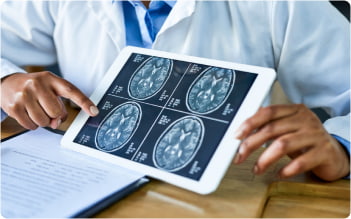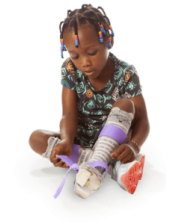Understanding cerebral palsy coexisting conditions
Cerebral palsy (CP) is caused by damage or malformation in the areas of the brain that control motor function during fetal development.
Children with CP often have coexisting conditions, which are additional health issues that occur along with cerebral palsy.
These other conditions may result from cerebral palsy or an unrelated but common co-occurrence.
There are several categories of cerebral palsy coexisting conditions, including:
- Primary conditions (directly caused by cerebral palsy)
- Secondary conditions (resulting from primary conditions)
- Cerebral palsy comorbidities (commonly seen with CP but not caused by it)
- Unrelated coexisting conditions (not caused by cerebral palsy but often present)
Caring for a child with cerebral palsy coexisting conditions can feel overwhelming, with ongoing therapies, medical care, and special equipment often needed.
However, if medical mistakes played a role in causing your child's cerebral palsy, financial support may be available to help cover these costs.
Cerebral Palsy Guide is committed to helping families affected by CP. We have partnered with a nationwide network of skilled cerebral palsy lawyers who may be able to help you pursue the money you need for your child’s care.
Find out if we can connect you with a top CP lawyer near you.
Primary challenges of cerebral palsy
A primary condition is a direct result of the brain damage that causes cerebral palsy. Primary cerebral palsy coexisting conditions include impaired motor control and posture.
Learn more about these challenges of CP below.
Movement and coordination issues
These issues are primary symptoms of cerebral palsy coexisting conditions. They stem from the damage or malformation in the brain that controls motor function.
- Involuntary movements
- Muscle stiffness (spasticity)
- Poor muscle tone
This can affect both large movements, like walking and sitting, and smaller tasks, such as grasping objects or moving the hands and fingers.
Muscle weakness and difficulty with balance and posture are also common, leading to challenges in everyday activities and mobility limitations.
Speech and oral motor impairments
Many children with cerebral palsy coexisting conditions face oral motor impairments. These issues occur when the brain struggles to control the muscles needed for speech and swallowing.
Conditions like dysarthria, which causes slurred or slow speech, and apraxia of speech, where the brain has trouble coordinating the mouth muscles to form words, are common.
Speech therapy can help improve these challenges over time.
Secondary conditions related to cerebral palsy
These result from primary conditions and are only present because of cerebral palsy. Secondary conditions often associated with CP include difficulty feeding and swallowing, poor nutrition, and respiratory issues.
Learn more about secondary conditions related to CP below.
Feeding and swallowing difficulties
Children with cerebral palsy often have difficulty controlling the muscles in their mouth and throat. This can lead to problems with feeding (sucking, chewing, etc.) and dysphagia (difficulty swallowing).
Sometimes, people with dysphagia may experience pain when swallowing or be unable to swallow at all.
A videofluoroscopic swallow study (VFSS) is used to check if a child can eat safely. This study uses imaging to closely observe the different stages of swallowing and how the muscles in the mouth and throat work together.
It’s estimated that 85-90% of children with cerebral palsy experience feeding and swallowing difficulties, especially in moderate to severe cerebral palsy cases.
Those with impaired fine motor skills may also have trouble using their hands to transport food or drink to their mouth. These children may have to rely on a caregiver or assistive equipment to feed them.
Feeding and swallowing problems can lead to poor nutrition, dehydration, and low weight.
Oral motor impairment also causes drooling in about 30% of cerebral palsy patients. Excessive drooling can cause dehydration.
Additionally, gastroesophageal reflux disease (GERD) is common among those with cerebral palsy. GERD is a digestive disease in which stomach acid is regurgitated into the esophagus.
Problems with feeding and swallowing, as well as drooling, can be improved through speech and occupational therapy.
Breathing issues linked to cerebral palsy
Children with difficulty swallowing and/or GERD are at risk for aspiration, which occurs when food, liquids, saliva, or vomit are inhaled into the lungs.
Frequent aspiration can lead to respiratory problems, like aspiration pneumonia, which is when a lung infection develops and may be life-threatening.
In severe cases, children with cerebral palsy coexisting conditions may also experience chronic lung disease or require the use of breathing support devices, such as ventilators or oxygen therapy, to manage respiratory function.
Early intervention and careful management of feeding can help reduce these risks.
If you have questions about your child’s condition, Cerebral Palsy Guide has experienced registered nurses on staff who are here to help.
Connect with a nurse right now for free.
Dental issues associated with cerebral palsy
Cerebral palsy can affect a child's ability to maintain proper oral hygiene due to difficulties with muscle control and coordination.
- Cavities
- Gum disease
- Tooth decay
Cerebral palsy coexisting conditions like malocclusion (misalignment of teeth) and TMJ disorders (jaw joint issues) are also more common in children with cerebral palsy, further complicating dental care.
With the help of a dental care team, caregivers can develop a personalized care plan that addresses the specific needs of their child.
Daily brushing, fluoride treatments, adequate hydration, and regular dental checkups can help manage and prevent long-term oral health problems.
Cerebral palsy comorbidities
These are conditions that are unrelated to CP. Cerebral palsy comorbidities often occur with the condition, but the reason why is not yet known.
Learn more about cerebral palsy comorbidities below.
Cerebral palsy and ADHD
Attention-deficit hyperactivity disorder (ADHD) is a developmental disability characterized by inattention, distractibility, and impulsivity.
Children with ADHD as a cerebral palsy comorbidity may have a hard time staying focused and paying attention, which can make learning a challenge.
They may also have trouble controlling their behavior and struggle with hyperactivity — a higher-than-normal activity level. Children with ADHD often have issues in school and with social skills.
Approximately 3-5% of children have ADHD, and it’s more common in children with cerebral palsy or other brain disorders.
Cerebral palsy and autism
Autism spectrum disorder (ASD) is an umbrella term that describes a group of brain development disorders.
ASD is characterized by social impairments, verbal and nonverbal communication difficulties, and repetitive patterns of behavior.
About 1 in 36 children has ASD, according to 2024 data from the Centers for Disease Control and Prevention (CDC).
In one study published by the National Library of Medicine, an estimated 6% of children with cerebral palsy have co-occurring autism.
While it seems that autism is more common among children with cerebral palsy, the link between the two disorders is not yet known.
Cerebral palsy and epilepsy
Epilepsy, also known as seizure disorder, is not a disease. It is a spectrum condition characterized by unpredictable, recurrent seizures.
A seizure is a sudden surge of electrical activity in the brain that can cause involuntary movements and behavior changes.
30-50% of children with CP have epilepsy. Co-occurring epilepsy and cerebral palsy are more common among children who are unable to walk or have limited mobility.
The risk for physical injury is a concern with cerebral palsy and seizures, along with choking or aspiration if it occurs when eating.
Cerebral palsy and cancer
Research shows that children with cerebral palsy co-occurring-conditions are at a higher risk of developing cancer and other chronic diseases.
Factors like intellectual disabilities, obesity, and severe motor impairment may contribute to this increased risk.
Though cerebral palsy itself is not a direct cause of cancer, these related challenges make cancer more likely. Early detection, routine screenings, and specialized care can help manage both conditions effectively.
If your child with cerebral palsy has been diagnosed with cancer, working closely with your medical team is essential to develop a personalized treatment plan.
Unrelated cerebral palsy coexisting conditions
Some conditions commonly co-occur with cerebral palsy but are not caused by the same brain injury or malformation.
These types of cerebral palsy coexisting conditions include vision and hearing impairment (these can be secondary conditions in some cases), intellectual and learning disabilities, and more.
Learn more about other cerebral palsy coexisting conditions below.
Intellectual and learning disabilities
Intellectual impairment, characterized by below-average intellectual functioning, affects a child's cognitive abilities and adaptive behavior.
This means they may struggle with everyday tasks, problem-solving, and social interaction.
Intellectual disabilities are categorized as mild, moderate, or severe, with an estimated two-thirds of children with cerebral palsy affected.
Learning difficulties are also common in children with cerebral palsy. These can stem from neurological processing issues that interfere with basic skills like reading and writing, as well as more complex tasks like organization and abstract thinking.
Motor planning difficulties, or dyspraxia, often make it harder for children with cerebral palsy coexisting conditions to plan and execute movements, which can impact learning new tasks.
Additionally, perceptual difficulties — problems with processing visual or auditory information — can affect how children with cerebral palsy learn and interact with the world.
Children with cerebral palsy may also experience challenges related to fine and gross motor coordination and language, further complicating their ability to learn and engage in daily activities.
If your child’s condition was caused by medical malpractice during childbirth, you may be able to access the money you need to provide them with a more stable future.
Get a free case review right now to see if you could be eligible.
Vision impairments
Visual impairment refers to any kind of vision loss, not including blindness, which is when a person has a total lack of vision and can’t see any light at all.
- Amblyopia (lazy eye)
- Optic atrophy (deterioration of the optic nerve due to damage)
- Nystagmus (repetitive, uncontrollable eye movements in a vertical or horizontal direction)
- Visual field defects (loss of one side of the visual field)
- Refractive errors (near and farsightedness and astigmatism or blurred vision)
One in 10 children with cerebral palsy has a severe visual impairment. Nearly half of all children with spastic cerebral palsy have strabismus, also known as cross-eye.
Untreated strabismus can lead to loss of vision of the weak eye.
Hearing problems
Hearing impairment, also known as hearing loss, refers to any degree of impairment of the ability to hear sound. The degree of one’s hearing loss is measured on a scale and can be slight, mild, moderate, severe, or profound.
There are three main types of hearing loss, including:
- Conductive
- Sensorineural
- Mixed
Conductive hearing loss occurs when there is a problem in the outer or middle ear, which results in hearing only faint sounds. Conductive hearing loss can usually be corrected by medical or surgical intervention.
Sensorineural hearing loss occurs when the inner ear (cochlea) or the auditory nerve is damaged. This type of hearing impairment reduces the ability to hear faint sounds, and speech often sounds muffled. It usually cannot be corrected medically or surgically. This is the most common type of permanent hearing loss.
A person has mixed hearing loss if they have both conductive and sensorineural hearing loss in an ear. In this case, there is damage in the outer or middle ear and in the inner ear.
An estimated 20% of children with cerebral palsy have a hearing impairment.
Central hearing loss is a rare form of hearing impairment. With central hearing loss, the issue is in the central nervous system, not the ear. The person may be able to hear perfectly, but they cannot interpret or understand the language.
Early intervention is important because hearing problems can affect the child’s speech and communication skills.
Sensory processing issues
A child’s ability to process information from the senses may also be affected depending on the severity and extent of their brain injury.
This is called sensory processing disorder. Children with sensory processing disorder can experience increased or decreased sensory reactions, leading to problems with development and behavior.
For example, a child with an increased sensitivity to touch (known as hypersensitivity) may not like the feeling of certain textiles and will act out or scream if they come in contact with one.
On the other hand, a child with a decreased sensitivity to touch (known as hyposensitivity) may play aggressively or bump into things without showing pain, not knowing they have injured themselves.
Pain is an important signal from the body that helps a child know when to stop an action that will cause them harm. Therefore, they can be at risk for repeated or increased injuries.
Sensory abnormalities are common among children with other neurodevelopmental disorders, like autism.
Managing cerebral palsy and coexisting conditions
Treatment for cerebral palsy is different in each case. When determining the best course of treatment, it’s important to evaluate the severity of CP and coexisting conditions.
Many of the challenges associated with cerebral palsy coexisting conditions can be managed or improved with a comprehensive treatment plan.
Creating a treatment plan
A treatment plan that addresses your child’s cerebral palsy coexisting conditions will provide the best chance for an improved quality of life.
The plan should consider not only the severity of their cerebral palsy but also any additional challenges they may face, like intellectual disabilities or movement difficulties.
- Assistive technology experts
- Dieticians
- Gastrointestinal doctors
- Mental health professionals
- Neurologists
- Orthopedic surgeons
- Pediatricians
- Physical therapy practitioners
- Rehabilitation medicine specialists
- Sleep medicine specialists
- Speech-language pathologists
It’s important to keep your child’s cerebral palsy treatment plan flexible and adjust it as they grow and their needs change.
Managing these conditions can be expensive. If your child's cerebral palsy was the result of medical negligence, there may be cerebral palsy financial assistance available to help cover treatment costs.
Support for families of children with cerebral palsy
There are many circumstances where cerebral palsy could have been prevented, which means it may have been caused by medical negligence. In these cases, affected families may be entitled to legal compensation from a cerebral palsy lawsuit.
Cerebral palsy lawsuit compensation can be used to help pay for past and future medical costs associated with treatment for your child’s cerebral palsy coexisting conditions.
Our legal partners have recovered over $962 million for families nationwide impacted by preventable birth injuries.
If you believe your child's cerebral palsy is the result of medical negligence, one of the best ways to seek the money you need for your child’s care is through a lawsuit.
Call one of our trained patient advocates at (855) 220-1101 or get a free case review to see if we can help.






